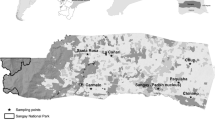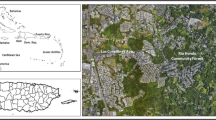Abstract
Despite the importance of neotropical cloud forests as providers of ecosystem services to society, they are one of the most threatened ecosystems in the world. We analysed the importance of three cloud forest reserves in central Colombia as providers of ecosystem services, as well as the social support to conservation actions in these ecosystems through willingness to pay (WTP) and willingness to give up time (WTT) estimates. Our results highlight the high commitment of all users of the cloud forest areas towards the conservation of the ecosystem services provided by these strategic ecosystems. We found that the most important perceived ecosystem services were water supply and habitat maintenance for species. Our findings also suggest that the respondents’ ecological knowledge (measured as the awareness of the ecosystem services supplied by cloud forests) was an important factor in determining both WTP and WTT for conserving cloud forests. Moreover, our results indicate that WTT should be a viable technique to explore individual preferences of different stakeholders towards conservation activities in cloud forests. Based on our results, we propose a conservation strategy of cloud forests that considers different users’ socio-economic and environmental characteristics, in which both experimental and experiential knowledge should be incorporated in order to promote collective action.


Similar content being viewed by others
References
Aldrich M, Hostettler S (2000) Tropical montane cloud forest, time for action. UNEP-World Conservation Monitoring Centre, Cambridge
Armenteras D, Cadena VC, Moreno RP (2007) Evaluación del estado de los bosques de niebla y de la meta 2010 en Colombia. Instituto de Investigación de Recursos Biológicos, Alexander von Humboldt, Bogotá
Armenteras D, Rodriguez N, Retana J (2009) Are conservation strategies effective in avoiding the deforestation of the Colombian Guyana Shield? Biol Conserv 142:1411–1419
Balisteri E, McClelland G, Poe G, Schulze W (2001) Can hypothetical questions reveal true answers? A laboratory comparison of dichotomous choice and open-ended contingent values with auction values. Environ Resour Econ 18:275–292
Barner JC, Mason HL, Murray MD (1999) Assessment of asthma patients’ willingness to pay for and give time to an asthma selfmanagement program. Clin Ther 21:878–894
BirdLife International (2006) Fichas de especies migratorias neotropicales en las IBAs: Bosques de la Falla del Tequendama. http://www.birdlife.org. Accessed 1 Sept 2011
Bonnell M, Bruijnzeel LA (2005) Forests, water and people in the humid tropics: past present and future hydrological research for integrated land and water management. Cambridge University Press, Cambridge
Brechin SR, Wilhusen PR, Fortwangler CL, West PC (2002) Beyond the square wheel: toward a more comprehensive understanding of biodiversity conservation as social and political process. Soc Nat Resour 15:41–64
Brown T, Champ P, Bishop R, McCollum D (1996) Which response format reveals the truth about donations to a public good? Land Econ 72:152–166
Bruijnzeel LA (2004) Hydrological functions of tropical forests: not seeing the soil for the trees? Agric Ecosyst Environ 104:185–228
Bubb P, May I, Miles L, Sayer J (2004) Cloud forest agenda. UNEP-WCMC, Cambridge. http://www.unep-wcmc.org/resources/publications/UNEP_WCMC_bio_series/20.htm. Accessed 1 Sept 2011
Burnham KP, Anderson DR (2002) Model selection and multi-model inference: a practical information-theoretic approach. Springer, New York
Carson R, Groves T, Machina M (2000) Incentive and information properties of preference questions. Working Paper, Department of Economics, University of California, California, USA
de Groot R (2006) Function-analysis and valuation as a tool to assess land use conflicts in planning for sustainable, multi-functional landscapes. Landsc Urban Plan 75:175–186
Doumenge C, Gilmour D, Ruiz–Pérez M, Blockhus J (1995) Tropical montane cloud forest: conservation status and management issues. In: Hamilton LS, Juvik JO, Scatena FN (eds) Tropical montane cloud forest. Springer, New York, pp 24–37
Fazey I, Fazey JA, Salisbury JG, Lindenmayer DB, Dovers S (2006) The nature and role of experiential knowledge for environmental conservation. Environ Conserv 33:1–10
García-Llorente M, Martín-López B, Díaz S, Montes C (2011a) Can ecosystem properties be fully translated into service values? An economic valuation of aquatic plant services. Ecol Appl 21:3083–3103
García-Llorente M, Martín-López B, Montes C (2011b) Exploring the motivations of protesters in contingent valuation: insights for conservation policies. Environ Sci Policy 14:76–88
Guariguata MR, Balvanera P (2009) Tropical forest service flows: improving our understanding of the biophysical dimension of ecosystem services. For Ecol Manag 258:1825–1829
Gujarati DN (2003) Basic econometrics, 4th edn. McGraw Hill/Irwin, New York
Hardin JW (2003) The sandwich estimate of variance. In: Fomby TB, Hill RC (eds) Maximum likelihood estimation of misspecified models: twenty years later, advances in econometrics series (17). Elsevier, Oxford, pp 45–73
Higuera D, Martinez E (2006) Sequestration and storage capacity of carbon in the canopy oak trees and their epiphytes in a Neotropic Cloud Forest, Colombia. Lyonia 11:17–23
Johannesson M (1992) Economic evaluation of lipid lowering a feasibility test of the contingent valuation approach. Health Policy 20:309–320
Kahneman D, Ritov I (1994) Determinants of stated willingness to pay for public goods: a study in the headline method. J Risk Uncertain 9:5–38
Kahneman D, Ritov I, Schkade D (1999) Economic preferences or attitude expressions? An analysis of dollar responses to public issues. J Risk Uncertain 19:203–235
Kennedy P (2003) A guide to econometrics, 5th edn. The MIT Press, Massachusetts
Knegtering E, Hendrickx L, van der Windt HJ, Schoot Uiterkamp AJM (2002) Effects of Species’ characteristics on nongovernmental organizations’ attitudes toward species conservation policy. Environ Behav 34:378–400
Kniivilä M (2006) Users and non-users of conservation areas: are there differences in WTP, motives and the validity of responses in CVM surveys? Ecol Econ 59:530–539
Lindemann-Matthies P (2005) ‘Loveable’ mammals and ‘lifeless’ plants: how children’s interests in common local organisms can be enhanced through observation of nature. Int J Sci Educ 27:655–677
Martínez ML, Pérez-Maqueo O, Vázquez G, Castillo-Campos G, García-Franco J, Mehltreter K, Equihua M, Landgrave R (2009) Effects of land use change on biodiversity and ecosystem services in tropical montane cloud forests of Mexico. For Ecol Manag 258:1856–1863
Martín-López B, Montes C, Benayas J (2007) Influence of user characteristics on valuation of ecosystem services in Doñana natural protected area (south-west Spain). Environ Conserv 34:215–224
Martín-López B, Iniesta-Arandia I, García-Llorente M, Palomo I, Casado-Arzuaga I, García del Amo D, Gómez-Baggethun E, Oteros-Rozas E, Palacios-Agundez I, Willaarts B, González JA, Santos-Martín F, Onaindia M, López-Santiago C, Montes C (2012) Uncovering ecosystem service bundles through social preferences. PLoS ONE 7(6):e38970. doi:10.1371/journal.pone.0038970
Millennium Ecosystem Assessment (MA) (2005) Ecosystems and human well-being: synthesis. Island Press, Washington, DC
Mitchell RC, Carson RT (1989) Using survey to value public goods. The contingent valuation method. Resources for the Future, Washington, DC
Mulligan M, Burke SM (2005) DFID FRP ZF-0216, Global Cloud Forest and Environmental Change in a Hydrological Context. Final Report. p 74. http://www.ambiotek.com/cloudforests/cloudforest_finalrep.pdf. Accessed 15 Aug 2011
Notaro S, Paletto A (2011) Links between mountain communities and environmental services in the Italian Alps. Sociol Ruralis 51:137–157
Pascual U, Muradian R, Brander L, Gómez-Baggethun E, Martín-López B, Verma M, Armsworth P, Christie M, Cornelissen H, Eppink F, Farley J, Loomis J, Pearson L, Perrings C, Polasky S (2010) The economics of valuing ecosystem services and biodiversity. In: Kumar P (ed) The economics of ecosystems and biodiversity: ecological and economic foundations. Earthscan, London, pp 184–255
Pretty J, Smith D (2004) Social capital in biodiversity conservation and management. Conserv Biol 18:631–638
Sagoff M (1998) Aggregation and deliberation in valuing environmental public goods: a look beyond contingent pricing. Ecol Econ 24:213–230
Sigelman L, Zeng L (1999) Analyzing censored and sample-selected data with Tobit and Heckit models. Polit Anal 8:167–182
Solano C (2006) Reserva Biológica Cachalu. 10 años de investigación en bosques de roble. In: Solano C, Vargas N (eds) Memorias del I simposio internacional de Robles y Ecosistemas asociados. Fundación Natura—Pontificia Universidad Javeriana, Bogotá, Colombia, pp 11–23
Stevens T, Echeverría J, Glass R, Hager T, More T (1991) Measuring the existence value of wildlife: what do CVM estimates really show? Land Econ 67:390–400
Thompson I, Mackey B, McNulty S, Mosseler A (2009) Forest resilience, biodiversity, and climate change. A synthesis of the biodiversity/resilience/stability relationship in forest ecosystems. Secretariat of the Convention on Biological Diversity, Technical Series no. 43, Montreal, Canadá
van Helvoort-Postulart D, Dirksen CD, Kessels AGH, van Engelshoven JMA, Hunink MGM (2009) A comparison between willingness to pay and willingness to give up time. Eur J Health Econ 10:81–91
van Hore C (1996) Counting the social costs: electricity and externalities in South Africa. University of Cape Town Press, Cape Town
Veall MR, Zimmermann KF (1992) Pseudo-R2s in the ordinal probit model. J Math Sociol 16:333–342
Ward J (1963) Hierarchical grouping to optimize and objective function. J Am Stat Assoc 58:236–244
Zaradic PA, Pergams ORW, Kareiva P (2009) The impact of nature experience on willingness to support conservation. PLoS ONE 4:e7367
Acknowledgments
We thank the Macanal Forest Reserve, Chicaque Natural Park and San Jose Reserve (Pedro Palo), and the resident population of the Chicaque Village, The Leisure and Monte Redondo. We also thank Marina García-Llorente for inspiring ideas about WTT as vehicle payment and two anonymous reviewers for constructive comments on early version of the manuscript.
Author information
Authors and Affiliations
Corresponding authors
Electronic supplementary material
Below is the link to the electronic supplementary material.
Rights and permissions
About this article
Cite this article
Higuera, D., Martín-López, B. & Sánchez-Jabba, A. Social preferences towards ecosystem services provided by cloud forests in the neotropics: implications for conservation strategies. Reg Environ Change 13, 861–872 (2013). https://doi.org/10.1007/s10113-012-0379-1
Received:
Accepted:
Published:
Issue Date:
DOI: https://doi.org/10.1007/s10113-012-0379-1




